Health Promotion Strategies for Obesity Management
VerifiedAdded on 2023/06/04
|13
|3783
|235
Essay
AI Summary
This essay explores the critical need for health promotion in addressing the rising rates of obesity, particularly in developing countries like Kenya. It highlights the risk factors associated with obesity, including physical inactivity, unhealthy dietary habits, and hormonal contraception, and their implications on individual and population health, such as cardiovascular diseases and diabetes mellitus type 2. The essay emphasizes the importance of health promotion strategies in mitigating these risks by encouraging physical activity, promoting healthy diets rich in whole foods, and educating women about the potential side effects of hormonal contraception. It also touches upon the role of genetics and other medical conditions in obesity. The essay further discusses the implications of obesity, such as cardiovascular diseases and diabetes mellitus type 2, underscoring the importance of preventive measures. It concludes by advocating for policy changes and innovative practices to enhance health promotion efforts and reduce the burden of obesity and associated conditions.

Obesity 1
OBESITY HEALTH PROMOTION
By (Student’s Name)
Course Title
Tutor’s Name
University’s Name
Date
OBESITY HEALTH PROMOTION
By (Student’s Name)
Course Title
Tutor’s Name
University’s Name
Date
Paraphrase This Document
Need a fresh take? Get an instant paraphrase of this document with our AI Paraphraser
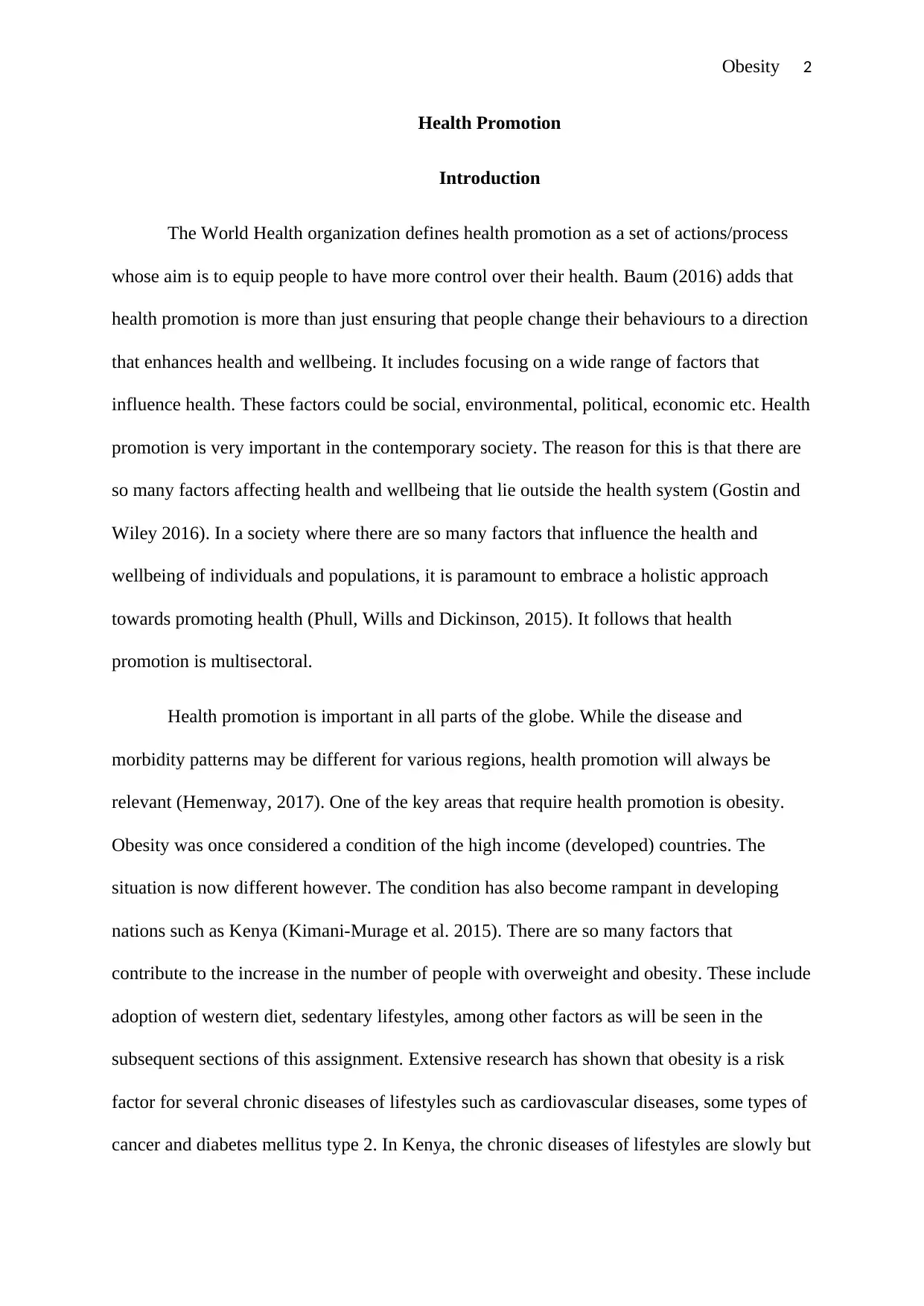
Obesity 2
Health Promotion
Introduction
The World Health organization defines health promotion as a set of actions/process
whose aim is to equip people to have more control over their health. Baum (2016) adds that
health promotion is more than just ensuring that people change their behaviours to a direction
that enhances health and wellbeing. It includes focusing on a wide range of factors that
influence health. These factors could be social, environmental, political, economic etc. Health
promotion is very important in the contemporary society. The reason for this is that there are
so many factors affecting health and wellbeing that lie outside the health system (Gostin and
Wiley 2016). In a society where there are so many factors that influence the health and
wellbeing of individuals and populations, it is paramount to embrace a holistic approach
towards promoting health (Phull, Wills and Dickinson, 2015). It follows that health
promotion is multisectoral.
Health promotion is important in all parts of the globe. While the disease and
morbidity patterns may be different for various regions, health promotion will always be
relevant (Hemenway, 2017). One of the key areas that require health promotion is obesity.
Obesity was once considered a condition of the high income (developed) countries. The
situation is now different however. The condition has also become rampant in developing
nations such as Kenya (Kimani-Murage et al. 2015). There are so many factors that
contribute to the increase in the number of people with overweight and obesity. These include
adoption of western diet, sedentary lifestyles, among other factors as will be seen in the
subsequent sections of this assignment. Extensive research has shown that obesity is a risk
factor for several chronic diseases of lifestyles such as cardiovascular diseases, some types of
cancer and diabetes mellitus type 2. In Kenya, the chronic diseases of lifestyles are slowly but
Health Promotion
Introduction
The World Health organization defines health promotion as a set of actions/process
whose aim is to equip people to have more control over their health. Baum (2016) adds that
health promotion is more than just ensuring that people change their behaviours to a direction
that enhances health and wellbeing. It includes focusing on a wide range of factors that
influence health. These factors could be social, environmental, political, economic etc. Health
promotion is very important in the contemporary society. The reason for this is that there are
so many factors affecting health and wellbeing that lie outside the health system (Gostin and
Wiley 2016). In a society where there are so many factors that influence the health and
wellbeing of individuals and populations, it is paramount to embrace a holistic approach
towards promoting health (Phull, Wills and Dickinson, 2015). It follows that health
promotion is multisectoral.
Health promotion is important in all parts of the globe. While the disease and
morbidity patterns may be different for various regions, health promotion will always be
relevant (Hemenway, 2017). One of the key areas that require health promotion is obesity.
Obesity was once considered a condition of the high income (developed) countries. The
situation is now different however. The condition has also become rampant in developing
nations such as Kenya (Kimani-Murage et al. 2015). There are so many factors that
contribute to the increase in the number of people with overweight and obesity. These include
adoption of western diet, sedentary lifestyles, among other factors as will be seen in the
subsequent sections of this assignment. Extensive research has shown that obesity is a risk
factor for several chronic diseases of lifestyles such as cardiovascular diseases, some types of
cancer and diabetes mellitus type 2. In Kenya, the chronic diseases of lifestyles are slowly but
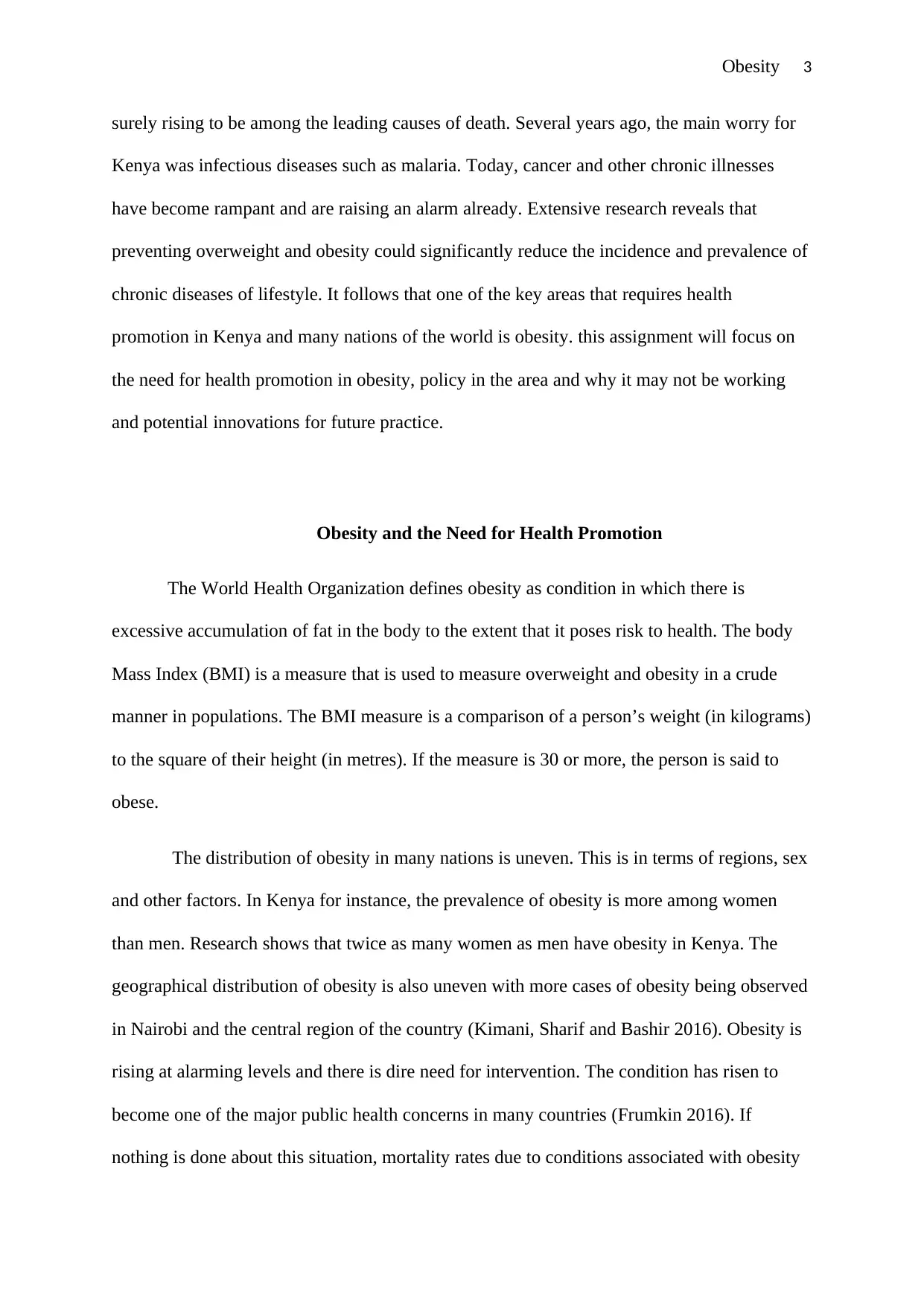
Obesity 3
surely rising to be among the leading causes of death. Several years ago, the main worry for
Kenya was infectious diseases such as malaria. Today, cancer and other chronic illnesses
have become rampant and are raising an alarm already. Extensive research reveals that
preventing overweight and obesity could significantly reduce the incidence and prevalence of
chronic diseases of lifestyle. It follows that one of the key areas that requires health
promotion in Kenya and many nations of the world is obesity. this assignment will focus on
the need for health promotion in obesity, policy in the area and why it may not be working
and potential innovations for future practice.
Obesity and the Need for Health Promotion
The World Health Organization defines obesity as condition in which there is
excessive accumulation of fat in the body to the extent that it poses risk to health. The body
Mass Index (BMI) is a measure that is used to measure overweight and obesity in a crude
manner in populations. The BMI measure is a comparison of a person’s weight (in kilograms)
to the square of their height (in metres). If the measure is 30 or more, the person is said to
obese.
The distribution of obesity in many nations is uneven. This is in terms of regions, sex
and other factors. In Kenya for instance, the prevalence of obesity is more among women
than men. Research shows that twice as many women as men have obesity in Kenya. The
geographical distribution of obesity is also uneven with more cases of obesity being observed
in Nairobi and the central region of the country (Kimani, Sharif and Bashir 2016). Obesity is
rising at alarming levels and there is dire need for intervention. The condition has risen to
become one of the major public health concerns in many countries (Frumkin 2016). If
nothing is done about this situation, mortality rates due to conditions associated with obesity
surely rising to be among the leading causes of death. Several years ago, the main worry for
Kenya was infectious diseases such as malaria. Today, cancer and other chronic illnesses
have become rampant and are raising an alarm already. Extensive research reveals that
preventing overweight and obesity could significantly reduce the incidence and prevalence of
chronic diseases of lifestyle. It follows that one of the key areas that requires health
promotion in Kenya and many nations of the world is obesity. this assignment will focus on
the need for health promotion in obesity, policy in the area and why it may not be working
and potential innovations for future practice.
Obesity and the Need for Health Promotion
The World Health Organization defines obesity as condition in which there is
excessive accumulation of fat in the body to the extent that it poses risk to health. The body
Mass Index (BMI) is a measure that is used to measure overweight and obesity in a crude
manner in populations. The BMI measure is a comparison of a person’s weight (in kilograms)
to the square of their height (in metres). If the measure is 30 or more, the person is said to
obese.
The distribution of obesity in many nations is uneven. This is in terms of regions, sex
and other factors. In Kenya for instance, the prevalence of obesity is more among women
than men. Research shows that twice as many women as men have obesity in Kenya. The
geographical distribution of obesity is also uneven with more cases of obesity being observed
in Nairobi and the central region of the country (Kimani, Sharif and Bashir 2016). Obesity is
rising at alarming levels and there is dire need for intervention. The condition has risen to
become one of the major public health concerns in many countries (Frumkin 2016). If
nothing is done about this situation, mortality rates due to conditions associated with obesity
⊘ This is a preview!⊘
Do you want full access?
Subscribe today to unlock all pages.

Trusted by 1+ million students worldwide
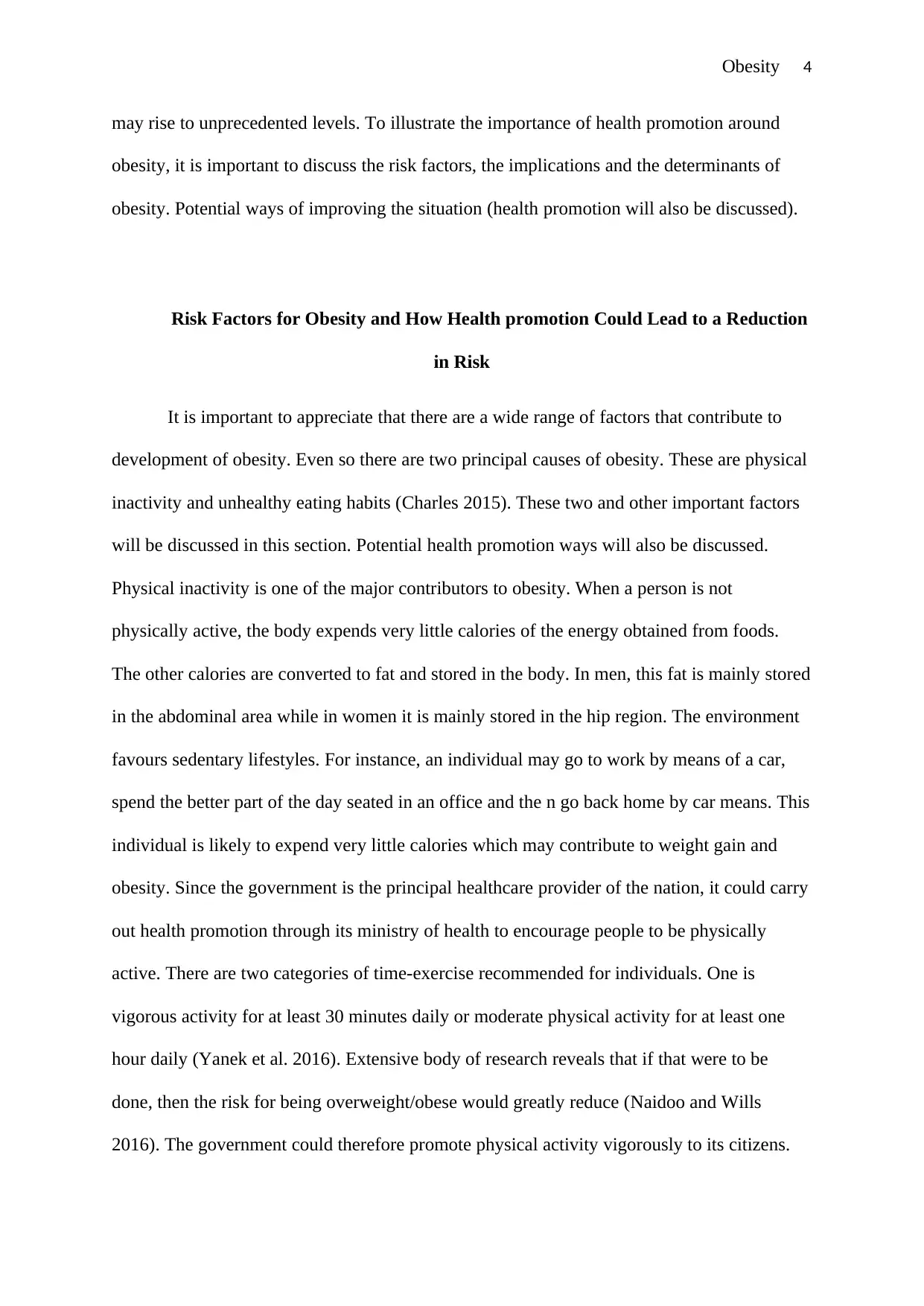
Obesity 4
may rise to unprecedented levels. To illustrate the importance of health promotion around
obesity, it is important to discuss the risk factors, the implications and the determinants of
obesity. Potential ways of improving the situation (health promotion will also be discussed).
Risk Factors for Obesity and How Health promotion Could Lead to a Reduction
in Risk
It is important to appreciate that there are a wide range of factors that contribute to
development of obesity. Even so there are two principal causes of obesity. These are physical
inactivity and unhealthy eating habits (Charles 2015). These two and other important factors
will be discussed in this section. Potential health promotion ways will also be discussed.
Physical inactivity is one of the major contributors to obesity. When a person is not
physically active, the body expends very little calories of the energy obtained from foods.
The other calories are converted to fat and stored in the body. In men, this fat is mainly stored
in the abdominal area while in women it is mainly stored in the hip region. The environment
favours sedentary lifestyles. For instance, an individual may go to work by means of a car,
spend the better part of the day seated in an office and the n go back home by car means. This
individual is likely to expend very little calories which may contribute to weight gain and
obesity. Since the government is the principal healthcare provider of the nation, it could carry
out health promotion through its ministry of health to encourage people to be physically
active. There are two categories of time-exercise recommended for individuals. One is
vigorous activity for at least 30 minutes daily or moderate physical activity for at least one
hour daily (Yanek et al. 2016). Extensive body of research reveals that if that were to be
done, then the risk for being overweight/obese would greatly reduce (Naidoo and Wills
2016). The government could therefore promote physical activity vigorously to its citizens.
may rise to unprecedented levels. To illustrate the importance of health promotion around
obesity, it is important to discuss the risk factors, the implications and the determinants of
obesity. Potential ways of improving the situation (health promotion will also be discussed).
Risk Factors for Obesity and How Health promotion Could Lead to a Reduction
in Risk
It is important to appreciate that there are a wide range of factors that contribute to
development of obesity. Even so there are two principal causes of obesity. These are physical
inactivity and unhealthy eating habits (Charles 2015). These two and other important factors
will be discussed in this section. Potential health promotion ways will also be discussed.
Physical inactivity is one of the major contributors to obesity. When a person is not
physically active, the body expends very little calories of the energy obtained from foods.
The other calories are converted to fat and stored in the body. In men, this fat is mainly stored
in the abdominal area while in women it is mainly stored in the hip region. The environment
favours sedentary lifestyles. For instance, an individual may go to work by means of a car,
spend the better part of the day seated in an office and the n go back home by car means. This
individual is likely to expend very little calories which may contribute to weight gain and
obesity. Since the government is the principal healthcare provider of the nation, it could carry
out health promotion through its ministry of health to encourage people to be physically
active. There are two categories of time-exercise recommended for individuals. One is
vigorous activity for at least 30 minutes daily or moderate physical activity for at least one
hour daily (Yanek et al. 2016). Extensive body of research reveals that if that were to be
done, then the risk for being overweight/obese would greatly reduce (Naidoo and Wills
2016). The government could therefore promote physical activity vigorously to its citizens.
Paraphrase This Document
Need a fresh take? Get an instant paraphrase of this document with our AI Paraphraser

Obesity 5
This would potentially lead to an increase in the nation’s level of physical activity. The
burden of obesity would then reduce saving the country of resources used in managing
obesity and associated condition.
The second principal determinant of obesity is dietary habits. The western diet has
been adopted in many countries of the world. This includes the developing countries such as
Kenya. The western diet is high in sugars and saturated fats. As opposed to the western diet,
the traditional African foods were high in fibre (whole foods), rich in nutrients and low in
saturated fats and sugars (Edelman, Mandle and Kudzma 2017). Consuming food that is high
in saturated fats and sugars contributes to obesity. This is how this happens. Fats and
saturated sugars are used to provide the body with energy once broken down. The excess fat
is stored in the body as fat stores. Excess sugar is also stored mainly in the forms of glycogen
and fat. Continued consumption of a diet that is high in fat and sugar will lead to excessive
accumulation of fat in the body leading to overweight/obesity.
A healthy diet on the other hand is defined as that rich in nutrients (nutrient dense)
and moderate/low in energy nutrients (DeBruyne, Pinna and Whitney 2015). These are
mainly the traditional foods that are whole and unprocessed. They are high in fibre and
nutrients such as vitamins and minerals. They also low in saturated fats and sugars.
Consumption of such foods helps the boy acquire all the nutrients required for normal
functioning while contributing very little fat or sugars (Hoffman et al 2017). The fats and
sugars contain in such foods are almost always only enough to fuel the normal bodily
functions. It follows that such a diet contributes no/little weight gain. Health promotion
should therefore be geared towards encouraging individuals to adopt diets that are mainly
composed of whole foods, fruits and vegetables. Public health campaigns should be increased
to ensure the same. Once the communities become knowledgeable of the importance of
This would potentially lead to an increase in the nation’s level of physical activity. The
burden of obesity would then reduce saving the country of resources used in managing
obesity and associated condition.
The second principal determinant of obesity is dietary habits. The western diet has
been adopted in many countries of the world. This includes the developing countries such as
Kenya. The western diet is high in sugars and saturated fats. As opposed to the western diet,
the traditional African foods were high in fibre (whole foods), rich in nutrients and low in
saturated fats and sugars (Edelman, Mandle and Kudzma 2017). Consuming food that is high
in saturated fats and sugars contributes to obesity. This is how this happens. Fats and
saturated sugars are used to provide the body with energy once broken down. The excess fat
is stored in the body as fat stores. Excess sugar is also stored mainly in the forms of glycogen
and fat. Continued consumption of a diet that is high in fat and sugar will lead to excessive
accumulation of fat in the body leading to overweight/obesity.
A healthy diet on the other hand is defined as that rich in nutrients (nutrient dense)
and moderate/low in energy nutrients (DeBruyne, Pinna and Whitney 2015). These are
mainly the traditional foods that are whole and unprocessed. They are high in fibre and
nutrients such as vitamins and minerals. They also low in saturated fats and sugars.
Consumption of such foods helps the boy acquire all the nutrients required for normal
functioning while contributing very little fat or sugars (Hoffman et al 2017). The fats and
sugars contain in such foods are almost always only enough to fuel the normal bodily
functions. It follows that such a diet contributes no/little weight gain. Health promotion
should therefore be geared towards encouraging individuals to adopt diets that are mainly
composed of whole foods, fruits and vegetables. Public health campaigns should be increased
to ensure the same. Once the communities become knowledgeable of the importance of

Obesity 6
healthy diets in promoting health, their attitudes will potentially be influenced. It has long
been known that once the attitudes are influenced, practice is highly probable.
Another main cause of obesity is the use of hormonal contraception methods. This
could probably explain the reason why the prevalence of obesity is higher among women in
Kenya. Research has revealed that the hormonal contraception methods could lead to
excessive accumulation of body fat in a short period of time. As Batras, Duff and Smith
(2016) observes, this is probably because the hormonal balance is affected by the methods.
The use of contraception, especially the hormonal methods is gaining momentum in the
developing countries and is contributing to the burden of overweigh, obesity and associated
conditions. Health promotion is therefore paramount when it comes to this issue. Women
should be made aware of the possible side effects of the contraception methods before they
can decide on the one best for them. Research should also be carried out to come up with
more contraception methods that are non-hormonal. It seems as if the best move would be to
encourage couples to consider using the non-hormonal methods of contraception as opposed
to the hormonal ones.
Genetics have also been implicated in causing obesity. Some individuals have genes
that code for accumulation of fat in the body and formation of fat cells (Agyemang et al.
2014). There are also other factors such as medical conditions that lead to accumulation of fat
such as hyperthyroidism. These causes are very rare in any population.
Implications of Obesity
To appreciate the importance of health promotion for obesity it is important to analyse
the implications it has on the health of individuals and populations. One of the implications is
cardiovascular diseases. These include hypertension, arteriosclerosis, and congestive heart
healthy diets in promoting health, their attitudes will potentially be influenced. It has long
been known that once the attitudes are influenced, practice is highly probable.
Another main cause of obesity is the use of hormonal contraception methods. This
could probably explain the reason why the prevalence of obesity is higher among women in
Kenya. Research has revealed that the hormonal contraception methods could lead to
excessive accumulation of body fat in a short period of time. As Batras, Duff and Smith
(2016) observes, this is probably because the hormonal balance is affected by the methods.
The use of contraception, especially the hormonal methods is gaining momentum in the
developing countries and is contributing to the burden of overweigh, obesity and associated
conditions. Health promotion is therefore paramount when it comes to this issue. Women
should be made aware of the possible side effects of the contraception methods before they
can decide on the one best for them. Research should also be carried out to come up with
more contraception methods that are non-hormonal. It seems as if the best move would be to
encourage couples to consider using the non-hormonal methods of contraception as opposed
to the hormonal ones.
Genetics have also been implicated in causing obesity. Some individuals have genes
that code for accumulation of fat in the body and formation of fat cells (Agyemang et al.
2014). There are also other factors such as medical conditions that lead to accumulation of fat
such as hyperthyroidism. These causes are very rare in any population.
Implications of Obesity
To appreciate the importance of health promotion for obesity it is important to analyse
the implications it has on the health of individuals and populations. One of the implications is
cardiovascular diseases. These include hypertension, arteriosclerosis, and congestive heart
⊘ This is a preview!⊘
Do you want full access?
Subscribe today to unlock all pages.

Trusted by 1+ million students worldwide
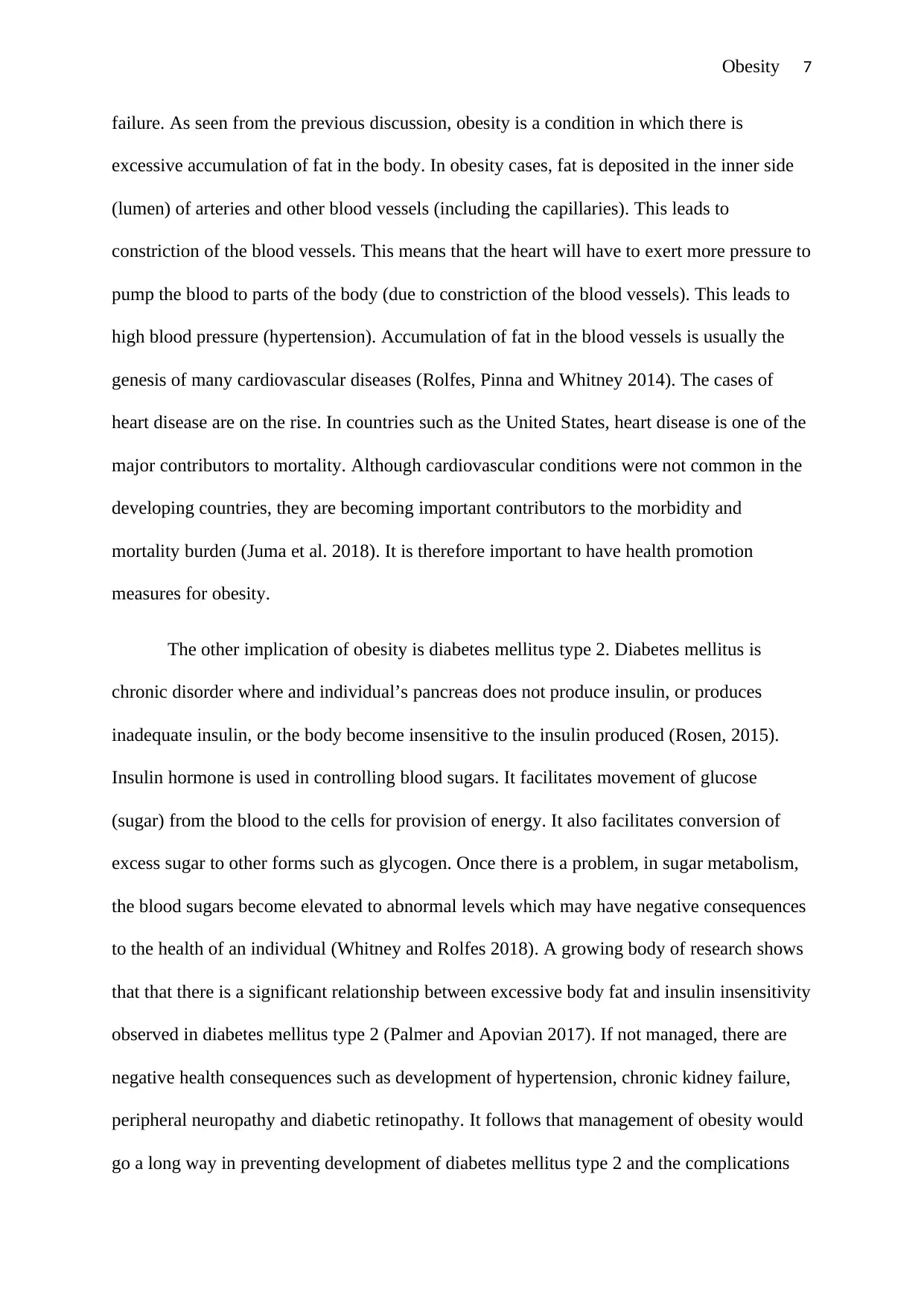
Obesity 7
failure. As seen from the previous discussion, obesity is a condition in which there is
excessive accumulation of fat in the body. In obesity cases, fat is deposited in the inner side
(lumen) of arteries and other blood vessels (including the capillaries). This leads to
constriction of the blood vessels. This means that the heart will have to exert more pressure to
pump the blood to parts of the body (due to constriction of the blood vessels). This leads to
high blood pressure (hypertension). Accumulation of fat in the blood vessels is usually the
genesis of many cardiovascular diseases (Rolfes, Pinna and Whitney 2014). The cases of
heart disease are on the rise. In countries such as the United States, heart disease is one of the
major contributors to mortality. Although cardiovascular conditions were not common in the
developing countries, they are becoming important contributors to the morbidity and
mortality burden (Juma et al. 2018). It is therefore important to have health promotion
measures for obesity.
The other implication of obesity is diabetes mellitus type 2. Diabetes mellitus is
chronic disorder where and individual’s pancreas does not produce insulin, or produces
inadequate insulin, or the body become insensitive to the insulin produced (Rosen, 2015).
Insulin hormone is used in controlling blood sugars. It facilitates movement of glucose
(sugar) from the blood to the cells for provision of energy. It also facilitates conversion of
excess sugar to other forms such as glycogen. Once there is a problem, in sugar metabolism,
the blood sugars become elevated to abnormal levels which may have negative consequences
to the health of an individual (Whitney and Rolfes 2018). A growing body of research shows
that that there is a significant relationship between excessive body fat and insulin insensitivity
observed in diabetes mellitus type 2 (Palmer and Apovian 2017). If not managed, there are
negative health consequences such as development of hypertension, chronic kidney failure,
peripheral neuropathy and diabetic retinopathy. It follows that management of obesity would
go a long way in preventing development of diabetes mellitus type 2 and the complications
failure. As seen from the previous discussion, obesity is a condition in which there is
excessive accumulation of fat in the body. In obesity cases, fat is deposited in the inner side
(lumen) of arteries and other blood vessels (including the capillaries). This leads to
constriction of the blood vessels. This means that the heart will have to exert more pressure to
pump the blood to parts of the body (due to constriction of the blood vessels). This leads to
high blood pressure (hypertension). Accumulation of fat in the blood vessels is usually the
genesis of many cardiovascular diseases (Rolfes, Pinna and Whitney 2014). The cases of
heart disease are on the rise. In countries such as the United States, heart disease is one of the
major contributors to mortality. Although cardiovascular conditions were not common in the
developing countries, they are becoming important contributors to the morbidity and
mortality burden (Juma et al. 2018). It is therefore important to have health promotion
measures for obesity.
The other implication of obesity is diabetes mellitus type 2. Diabetes mellitus is
chronic disorder where and individual’s pancreas does not produce insulin, or produces
inadequate insulin, or the body become insensitive to the insulin produced (Rosen, 2015).
Insulin hormone is used in controlling blood sugars. It facilitates movement of glucose
(sugar) from the blood to the cells for provision of energy. It also facilitates conversion of
excess sugar to other forms such as glycogen. Once there is a problem, in sugar metabolism,
the blood sugars become elevated to abnormal levels which may have negative consequences
to the health of an individual (Whitney and Rolfes 2018). A growing body of research shows
that that there is a significant relationship between excessive body fat and insulin insensitivity
observed in diabetes mellitus type 2 (Palmer and Apovian 2017). If not managed, there are
negative health consequences such as development of hypertension, chronic kidney failure,
peripheral neuropathy and diabetic retinopathy. It follows that management of obesity would
go a long way in preventing development of diabetes mellitus type 2 and the complications
Paraphrase This Document
Need a fresh take? Get an instant paraphrase of this document with our AI Paraphraser
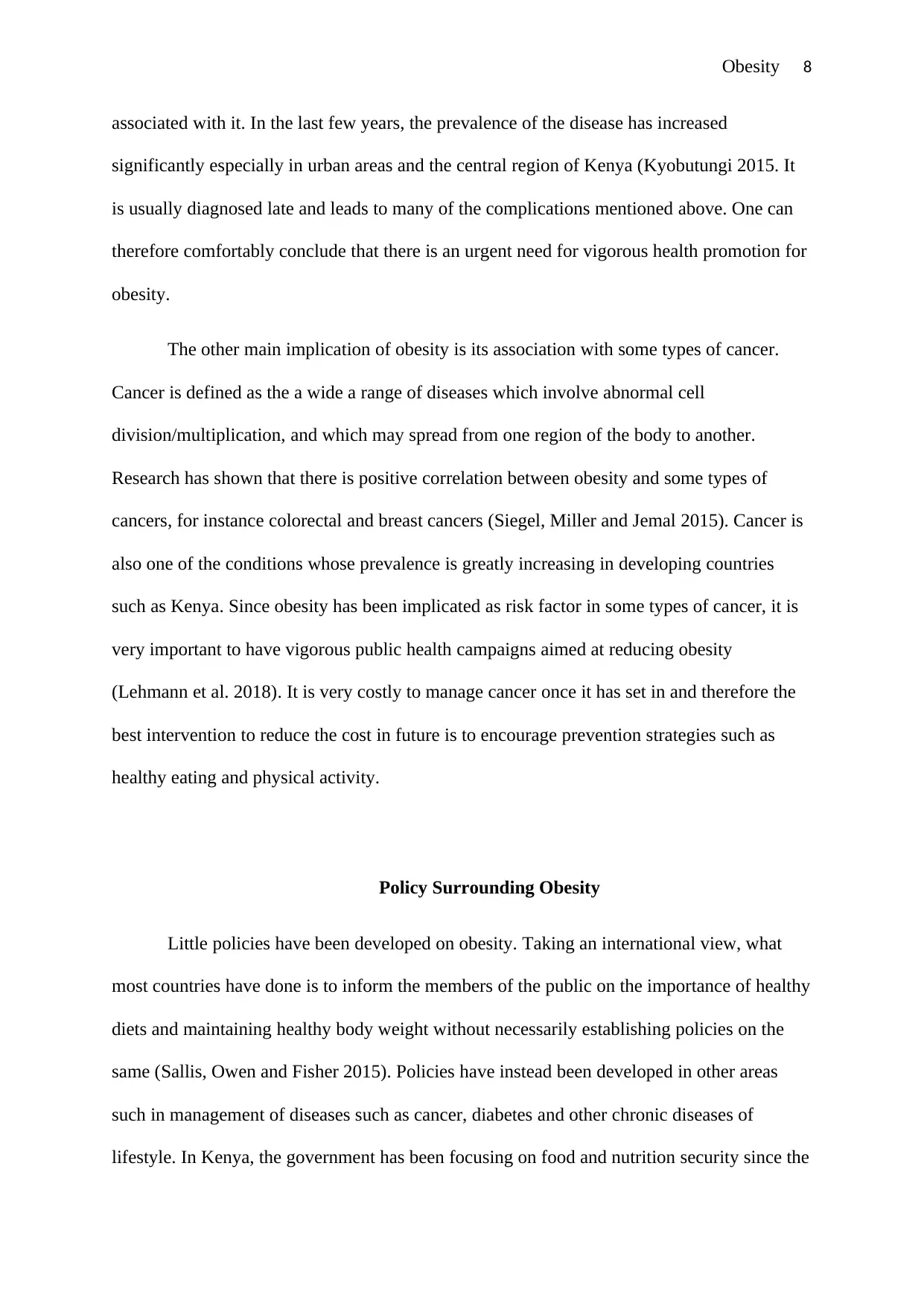
Obesity 8
associated with it. In the last few years, the prevalence of the disease has increased
significantly especially in urban areas and the central region of Kenya (Kyobutungi 2015. It
is usually diagnosed late and leads to many of the complications mentioned above. One can
therefore comfortably conclude that there is an urgent need for vigorous health promotion for
obesity.
The other main implication of obesity is its association with some types of cancer.
Cancer is defined as the a wide a range of diseases which involve abnormal cell
division/multiplication, and which may spread from one region of the body to another.
Research has shown that there is positive correlation between obesity and some types of
cancers, for instance colorectal and breast cancers (Siegel, Miller and Jemal 2015). Cancer is
also one of the conditions whose prevalence is greatly increasing in developing countries
such as Kenya. Since obesity has been implicated as risk factor in some types of cancer, it is
very important to have vigorous public health campaigns aimed at reducing obesity
(Lehmann et al. 2018). It is very costly to manage cancer once it has set in and therefore the
best intervention to reduce the cost in future is to encourage prevention strategies such as
healthy eating and physical activity.
Policy Surrounding Obesity
Little policies have been developed on obesity. Taking an international view, what
most countries have done is to inform the members of the public on the importance of healthy
diets and maintaining healthy body weight without necessarily establishing policies on the
same (Sallis, Owen and Fisher 2015). Policies have instead been developed in other areas
such in management of diseases such as cancer, diabetes and other chronic diseases of
lifestyle. In Kenya, the government has been focusing on food and nutrition security since the
associated with it. In the last few years, the prevalence of the disease has increased
significantly especially in urban areas and the central region of Kenya (Kyobutungi 2015. It
is usually diagnosed late and leads to many of the complications mentioned above. One can
therefore comfortably conclude that there is an urgent need for vigorous health promotion for
obesity.
The other main implication of obesity is its association with some types of cancer.
Cancer is defined as the a wide a range of diseases which involve abnormal cell
division/multiplication, and which may spread from one region of the body to another.
Research has shown that there is positive correlation between obesity and some types of
cancers, for instance colorectal and breast cancers (Siegel, Miller and Jemal 2015). Cancer is
also one of the conditions whose prevalence is greatly increasing in developing countries
such as Kenya. Since obesity has been implicated as risk factor in some types of cancer, it is
very important to have vigorous public health campaigns aimed at reducing obesity
(Lehmann et al. 2018). It is very costly to manage cancer once it has set in and therefore the
best intervention to reduce the cost in future is to encourage prevention strategies such as
healthy eating and physical activity.
Policy Surrounding Obesity
Little policies have been developed on obesity. Taking an international view, what
most countries have done is to inform the members of the public on the importance of healthy
diets and maintaining healthy body weight without necessarily establishing policies on the
same (Sallis, Owen and Fisher 2015). Policies have instead been developed in other areas
such in management of diseases such as cancer, diabetes and other chronic diseases of
lifestyle. In Kenya, the government has been focusing on food and nutrition security since the
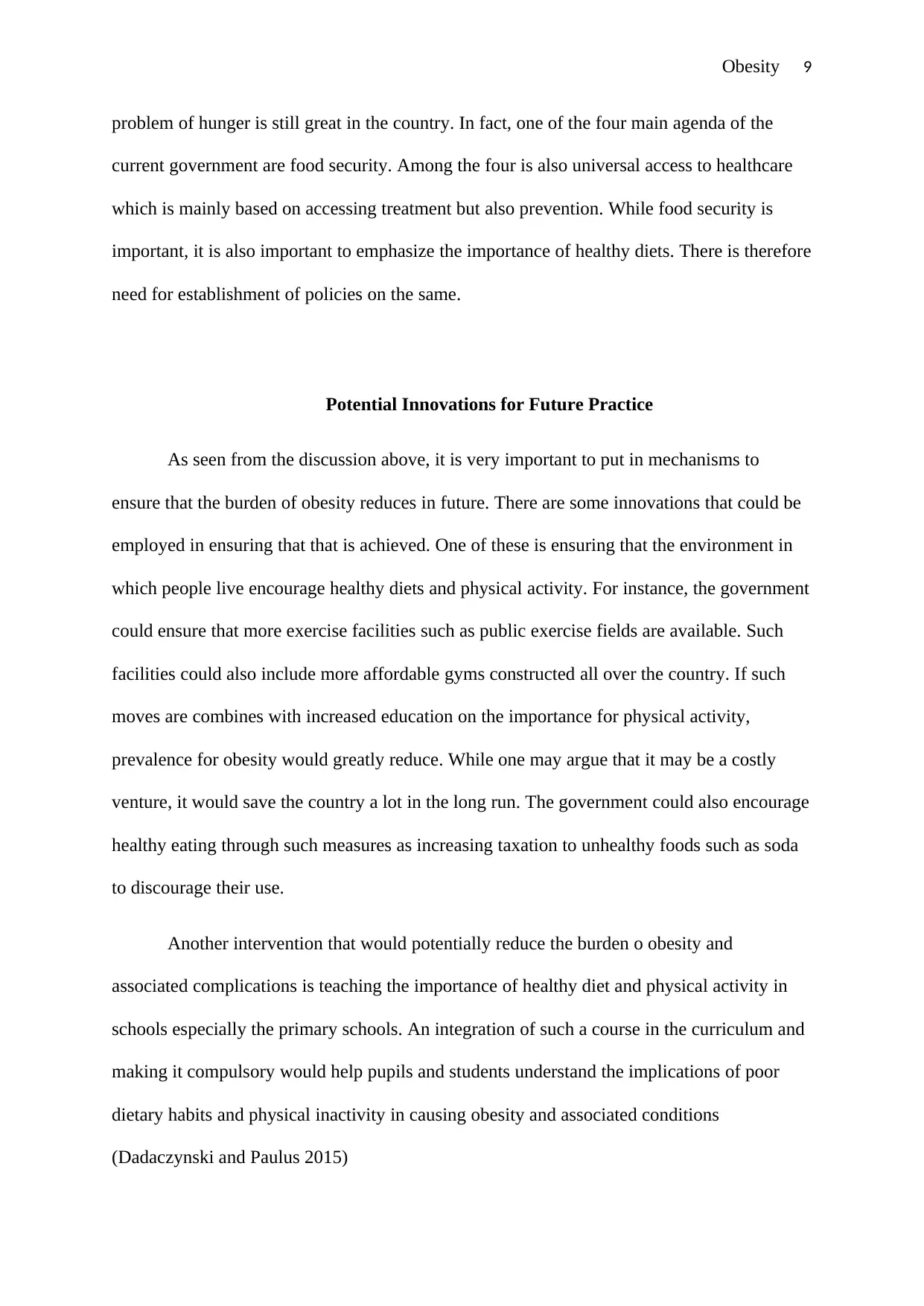
Obesity 9
problem of hunger is still great in the country. In fact, one of the four main agenda of the
current government are food security. Among the four is also universal access to healthcare
which is mainly based on accessing treatment but also prevention. While food security is
important, it is also important to emphasize the importance of healthy diets. There is therefore
need for establishment of policies on the same.
Potential Innovations for Future Practice
As seen from the discussion above, it is very important to put in mechanisms to
ensure that the burden of obesity reduces in future. There are some innovations that could be
employed in ensuring that that is achieved. One of these is ensuring that the environment in
which people live encourage healthy diets and physical activity. For instance, the government
could ensure that more exercise facilities such as public exercise fields are available. Such
facilities could also include more affordable gyms constructed all over the country. If such
moves are combines with increased education on the importance for physical activity,
prevalence for obesity would greatly reduce. While one may argue that it may be a costly
venture, it would save the country a lot in the long run. The government could also encourage
healthy eating through such measures as increasing taxation to unhealthy foods such as soda
to discourage their use.
Another intervention that would potentially reduce the burden o obesity and
associated complications is teaching the importance of healthy diet and physical activity in
schools especially the primary schools. An integration of such a course in the curriculum and
making it compulsory would help pupils and students understand the implications of poor
dietary habits and physical inactivity in causing obesity and associated conditions
(Dadaczynski and Paulus 2015)
problem of hunger is still great in the country. In fact, one of the four main agenda of the
current government are food security. Among the four is also universal access to healthcare
which is mainly based on accessing treatment but also prevention. While food security is
important, it is also important to emphasize the importance of healthy diets. There is therefore
need for establishment of policies on the same.
Potential Innovations for Future Practice
As seen from the discussion above, it is very important to put in mechanisms to
ensure that the burden of obesity reduces in future. There are some innovations that could be
employed in ensuring that that is achieved. One of these is ensuring that the environment in
which people live encourage healthy diets and physical activity. For instance, the government
could ensure that more exercise facilities such as public exercise fields are available. Such
facilities could also include more affordable gyms constructed all over the country. If such
moves are combines with increased education on the importance for physical activity,
prevalence for obesity would greatly reduce. While one may argue that it may be a costly
venture, it would save the country a lot in the long run. The government could also encourage
healthy eating through such measures as increasing taxation to unhealthy foods such as soda
to discourage their use.
Another intervention that would potentially reduce the burden o obesity and
associated complications is teaching the importance of healthy diet and physical activity in
schools especially the primary schools. An integration of such a course in the curriculum and
making it compulsory would help pupils and students understand the implications of poor
dietary habits and physical inactivity in causing obesity and associated conditions
(Dadaczynski and Paulus 2015)
⊘ This is a preview!⊘
Do you want full access?
Subscribe today to unlock all pages.

Trusted by 1+ million students worldwide
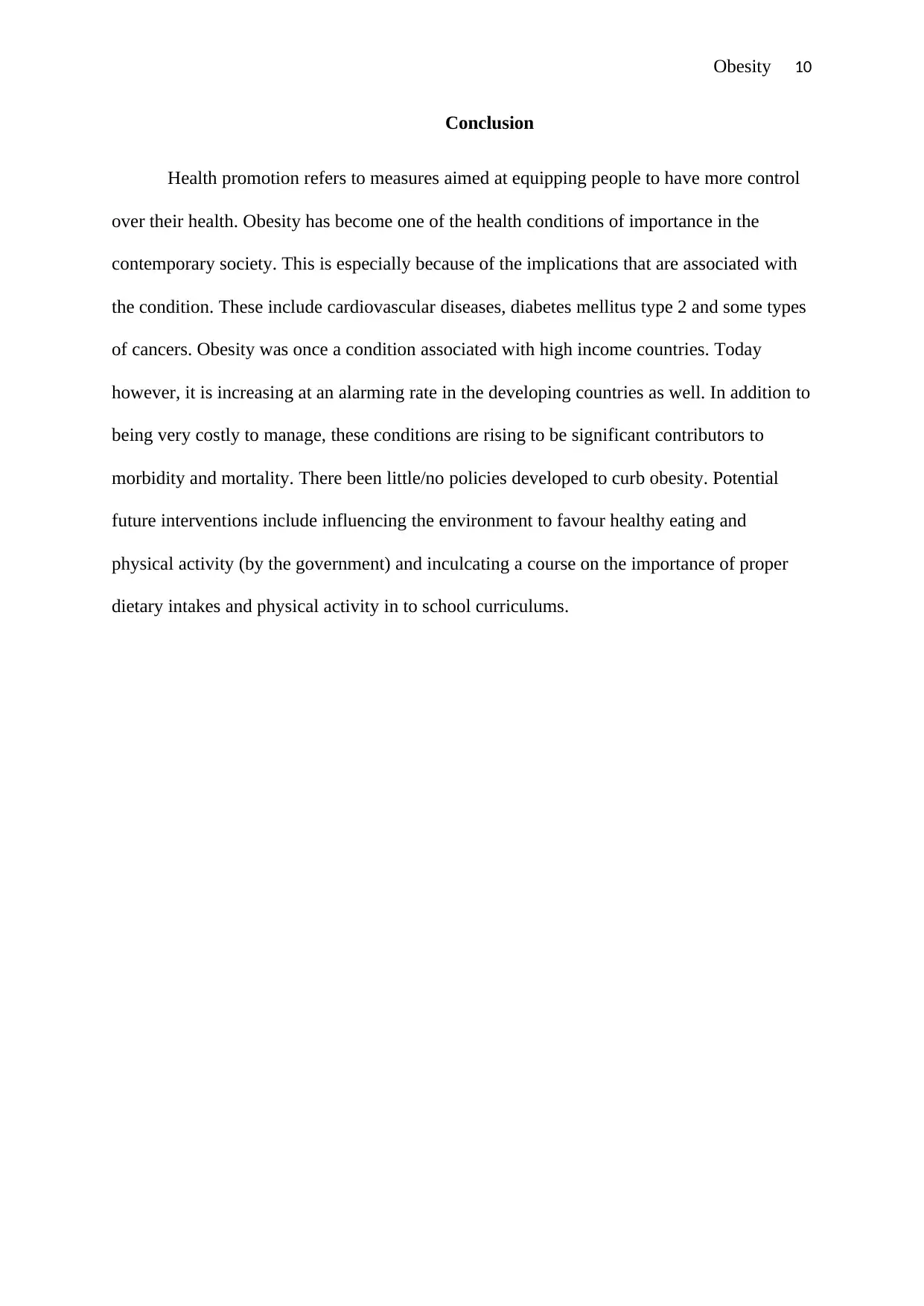
Obesity 10
Conclusion
Health promotion refers to measures aimed at equipping people to have more control
over their health. Obesity has become one of the health conditions of importance in the
contemporary society. This is especially because of the implications that are associated with
the condition. These include cardiovascular diseases, diabetes mellitus type 2 and some types
of cancers. Obesity was once a condition associated with high income countries. Today
however, it is increasing at an alarming rate in the developing countries as well. In addition to
being very costly to manage, these conditions are rising to be significant contributors to
morbidity and mortality. There been little/no policies developed to curb obesity. Potential
future interventions include influencing the environment to favour healthy eating and
physical activity (by the government) and inculcating a course on the importance of proper
dietary intakes and physical activity in to school curriculums.
Conclusion
Health promotion refers to measures aimed at equipping people to have more control
over their health. Obesity has become one of the health conditions of importance in the
contemporary society. This is especially because of the implications that are associated with
the condition. These include cardiovascular diseases, diabetes mellitus type 2 and some types
of cancers. Obesity was once a condition associated with high income countries. Today
however, it is increasing at an alarming rate in the developing countries as well. In addition to
being very costly to manage, these conditions are rising to be significant contributors to
morbidity and mortality. There been little/no policies developed to curb obesity. Potential
future interventions include influencing the environment to favour healthy eating and
physical activity (by the government) and inculcating a course on the importance of proper
dietary intakes and physical activity in to school curriculums.
Paraphrase This Document
Need a fresh take? Get an instant paraphrase of this document with our AI Paraphraser

Obesity 11
References
Agyemang, C., Boatemaa, S., Frempong, G.A. and Aikins, A.D.G., 2015. Obesity in Sub-
Saharan Africa. In Metabolic syndrome (pp. 1-13). Springer, Cham.
Batras, D., Duff, C. and Smith, B.J., 2016. Organizational change theory: implications for
health promotion practice. Health Promotion International, 31(1), pp.231-241.
Baum, F. (2016). The new public health (No. Ed. 4). Oxford University Press.
Charles, M.A. and Heude, B., 2015. Early determinants of obesity. Bulletin de l'Academie
nationale de medecine, 199(8-9), pp.1281-1289.
Dadaczynski, K. and Paulus, P., 2015. Healthy principals–healthy schools? A neglected
perspective to school health promotion. In Schools for Health and Sustainability (pp. 253-
273). Springer, Dordrecht.
DeBruyne, L.K., Pinna, K. and Whitney, E.N., 2015. Nutrition and diet therapy. Nelson
Education.
Edelman, C.L., Mandle, C.L. and Kudzma, E.C., 2017. Health Promotion Throughout the
Life Span-E-Book. Elsevier Health Sciences.
Frumkin, H., 2016. Urban sprawl and public health. Public health reports.
Gostin, L.O. and Wiley, L.F., 2016. Public health law: power, duty, restraint. University of
California Press.
Hemenway, D., 2017. Private guns, public health. University of Michigan Press.
Hoffman, D., Cacciola, T., Barrios, P. and Simon, J., 2017. Temporal changes and
determinants of childhood nutritional status in Kenya and Zambia. Journal of Health,
Population and Nutrition, 36(1), p.27.
References
Agyemang, C., Boatemaa, S., Frempong, G.A. and Aikins, A.D.G., 2015. Obesity in Sub-
Saharan Africa. In Metabolic syndrome (pp. 1-13). Springer, Cham.
Batras, D., Duff, C. and Smith, B.J., 2016. Organizational change theory: implications for
health promotion practice. Health Promotion International, 31(1), pp.231-241.
Baum, F. (2016). The new public health (No. Ed. 4). Oxford University Press.
Charles, M.A. and Heude, B., 2015. Early determinants of obesity. Bulletin de l'Academie
nationale de medecine, 199(8-9), pp.1281-1289.
Dadaczynski, K. and Paulus, P., 2015. Healthy principals–healthy schools? A neglected
perspective to school health promotion. In Schools for Health and Sustainability (pp. 253-
273). Springer, Dordrecht.
DeBruyne, L.K., Pinna, K. and Whitney, E.N., 2015. Nutrition and diet therapy. Nelson
Education.
Edelman, C.L., Mandle, C.L. and Kudzma, E.C., 2017. Health Promotion Throughout the
Life Span-E-Book. Elsevier Health Sciences.
Frumkin, H., 2016. Urban sprawl and public health. Public health reports.
Gostin, L.O. and Wiley, L.F., 2016. Public health law: power, duty, restraint. University of
California Press.
Hemenway, D., 2017. Private guns, public health. University of Michigan Press.
Hoffman, D., Cacciola, T., Barrios, P. and Simon, J., 2017. Temporal changes and
determinants of childhood nutritional status in Kenya and Zambia. Journal of Health,
Population and Nutrition, 36(1), p.27.
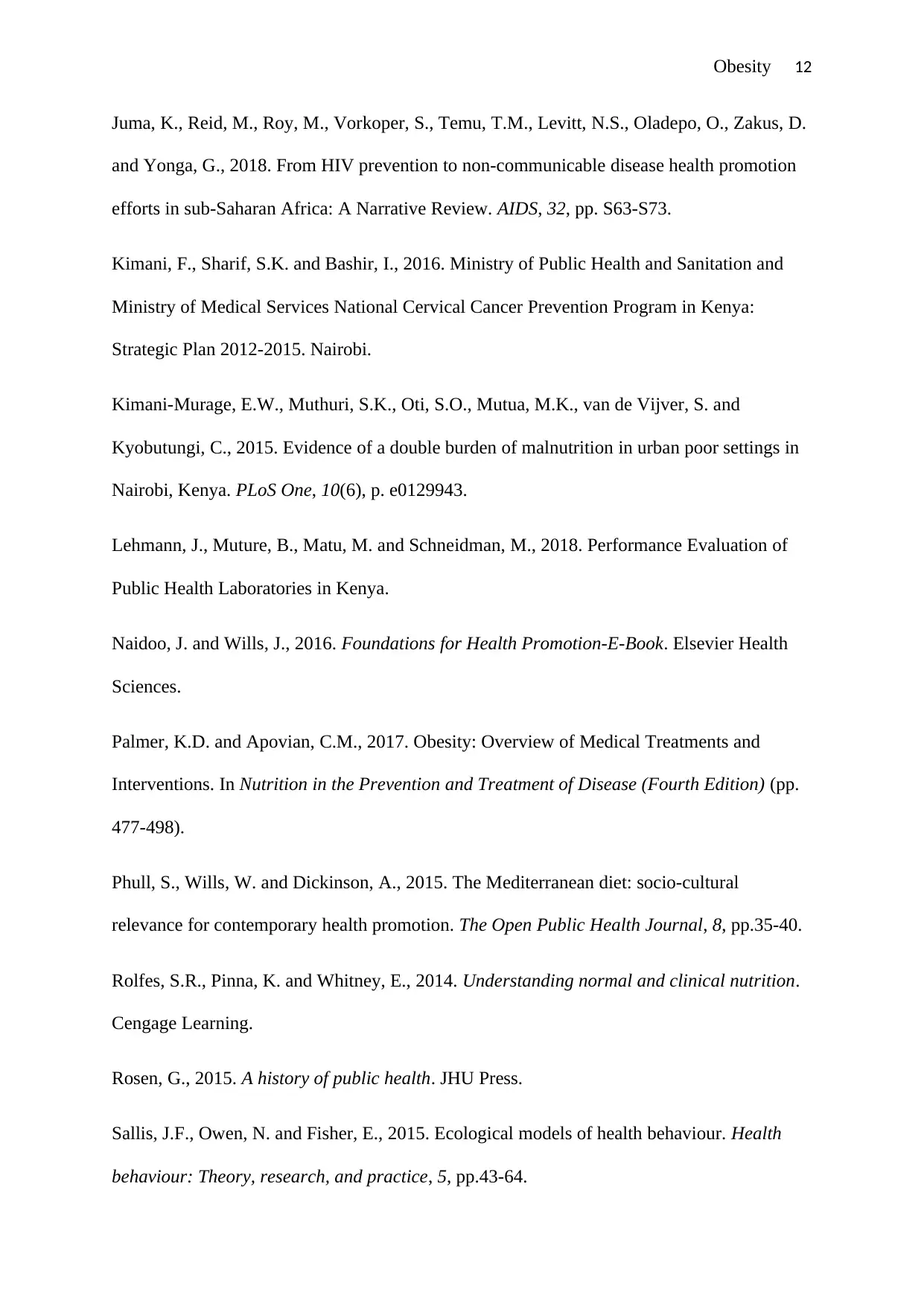
Obesity 12
Juma, K., Reid, M., Roy, M., Vorkoper, S., Temu, T.M., Levitt, N.S., Oladepo, O., Zakus, D.
and Yonga, G., 2018. From HIV prevention to non-communicable disease health promotion
efforts in sub-Saharan Africa: A Narrative Review. AIDS, 32, pp. S63-S73.
Kimani, F., Sharif, S.K. and Bashir, I., 2016. Ministry of Public Health and Sanitation and
Ministry of Medical Services National Cervical Cancer Prevention Program in Kenya:
Strategic Plan 2012-2015. Nairobi.
Kimani-Murage, E.W., Muthuri, S.K., Oti, S.O., Mutua, M.K., van de Vijver, S. and
Kyobutungi, C., 2015. Evidence of a double burden of malnutrition in urban poor settings in
Nairobi, Kenya. PLoS One, 10(6), p. e0129943.
Lehmann, J., Muture, B., Matu, M. and Schneidman, M., 2018. Performance Evaluation of
Public Health Laboratories in Kenya.
Naidoo, J. and Wills, J., 2016. Foundations for Health Promotion-E-Book. Elsevier Health
Sciences.
Palmer, K.D. and Apovian, C.M., 2017. Obesity: Overview of Medical Treatments and
Interventions. In Nutrition in the Prevention and Treatment of Disease (Fourth Edition) (pp.
477-498).
Phull, S., Wills, W. and Dickinson, A., 2015. The Mediterranean diet: socio-cultural
relevance for contemporary health promotion. The Open Public Health Journal, 8, pp.35-40.
Rolfes, S.R., Pinna, K. and Whitney, E., 2014. Understanding normal and clinical nutrition.
Cengage Learning.
Rosen, G., 2015. A history of public health. JHU Press.
Sallis, J.F., Owen, N. and Fisher, E., 2015. Ecological models of health behaviour. Health
behaviour: Theory, research, and practice, 5, pp.43-64.
Juma, K., Reid, M., Roy, M., Vorkoper, S., Temu, T.M., Levitt, N.S., Oladepo, O., Zakus, D.
and Yonga, G., 2018. From HIV prevention to non-communicable disease health promotion
efforts in sub-Saharan Africa: A Narrative Review. AIDS, 32, pp. S63-S73.
Kimani, F., Sharif, S.K. and Bashir, I., 2016. Ministry of Public Health and Sanitation and
Ministry of Medical Services National Cervical Cancer Prevention Program in Kenya:
Strategic Plan 2012-2015. Nairobi.
Kimani-Murage, E.W., Muthuri, S.K., Oti, S.O., Mutua, M.K., van de Vijver, S. and
Kyobutungi, C., 2015. Evidence of a double burden of malnutrition in urban poor settings in
Nairobi, Kenya. PLoS One, 10(6), p. e0129943.
Lehmann, J., Muture, B., Matu, M. and Schneidman, M., 2018. Performance Evaluation of
Public Health Laboratories in Kenya.
Naidoo, J. and Wills, J., 2016. Foundations for Health Promotion-E-Book. Elsevier Health
Sciences.
Palmer, K.D. and Apovian, C.M., 2017. Obesity: Overview of Medical Treatments and
Interventions. In Nutrition in the Prevention and Treatment of Disease (Fourth Edition) (pp.
477-498).
Phull, S., Wills, W. and Dickinson, A., 2015. The Mediterranean diet: socio-cultural
relevance for contemporary health promotion. The Open Public Health Journal, 8, pp.35-40.
Rolfes, S.R., Pinna, K. and Whitney, E., 2014. Understanding normal and clinical nutrition.
Cengage Learning.
Rosen, G., 2015. A history of public health. JHU Press.
Sallis, J.F., Owen, N. and Fisher, E., 2015. Ecological models of health behaviour. Health
behaviour: Theory, research, and practice, 5, pp.43-64.
⊘ This is a preview!⊘
Do you want full access?
Subscribe today to unlock all pages.

Trusted by 1+ million students worldwide
1 out of 13
Related Documents
Your All-in-One AI-Powered Toolkit for Academic Success.
+13062052269
info@desklib.com
Available 24*7 on WhatsApp / Email
![[object Object]](/_next/static/media/star-bottom.7253800d.svg)
Unlock your academic potential
Copyright © 2020–2025 A2Z Services. All Rights Reserved. Developed and managed by ZUCOL.





